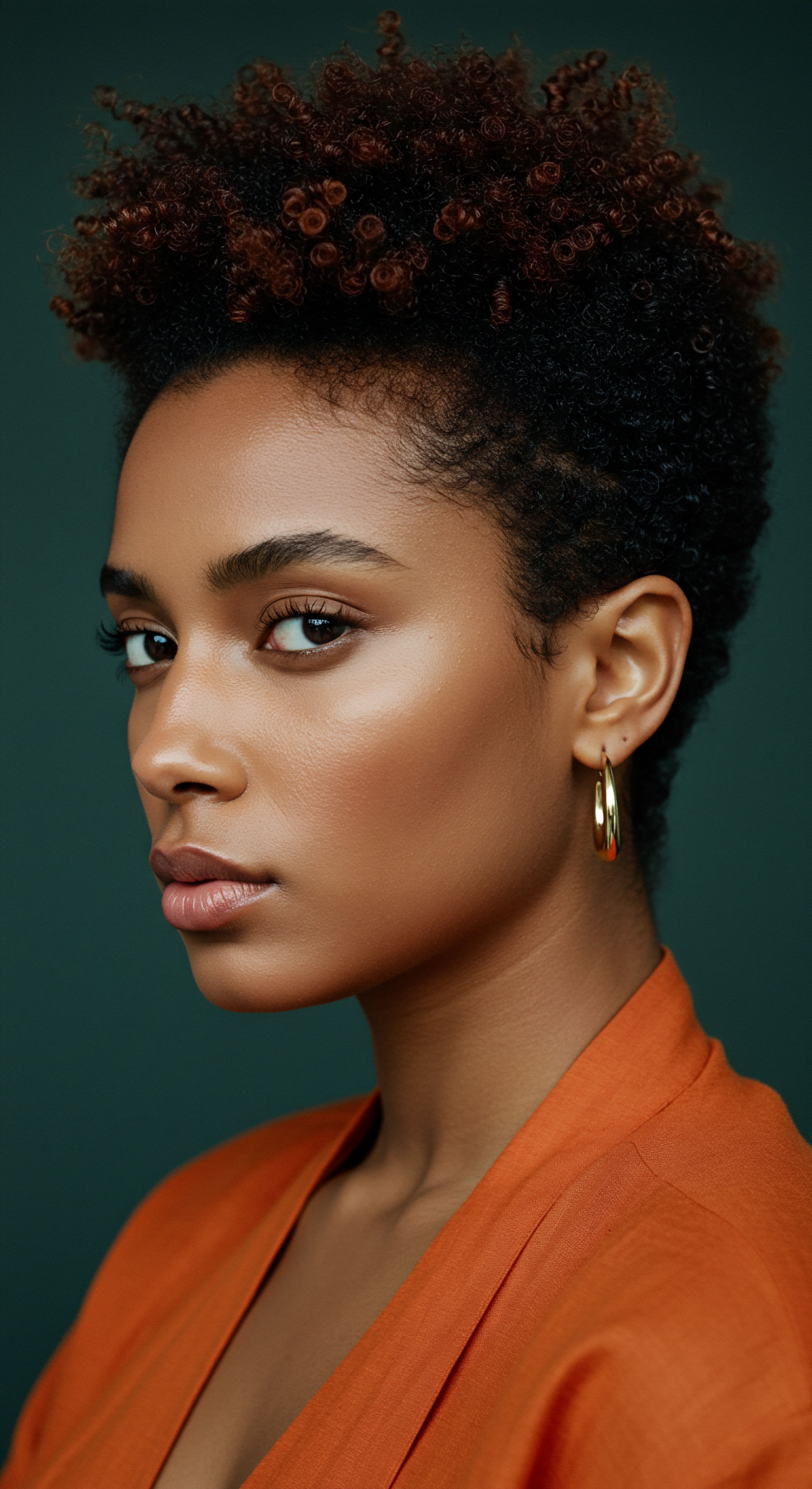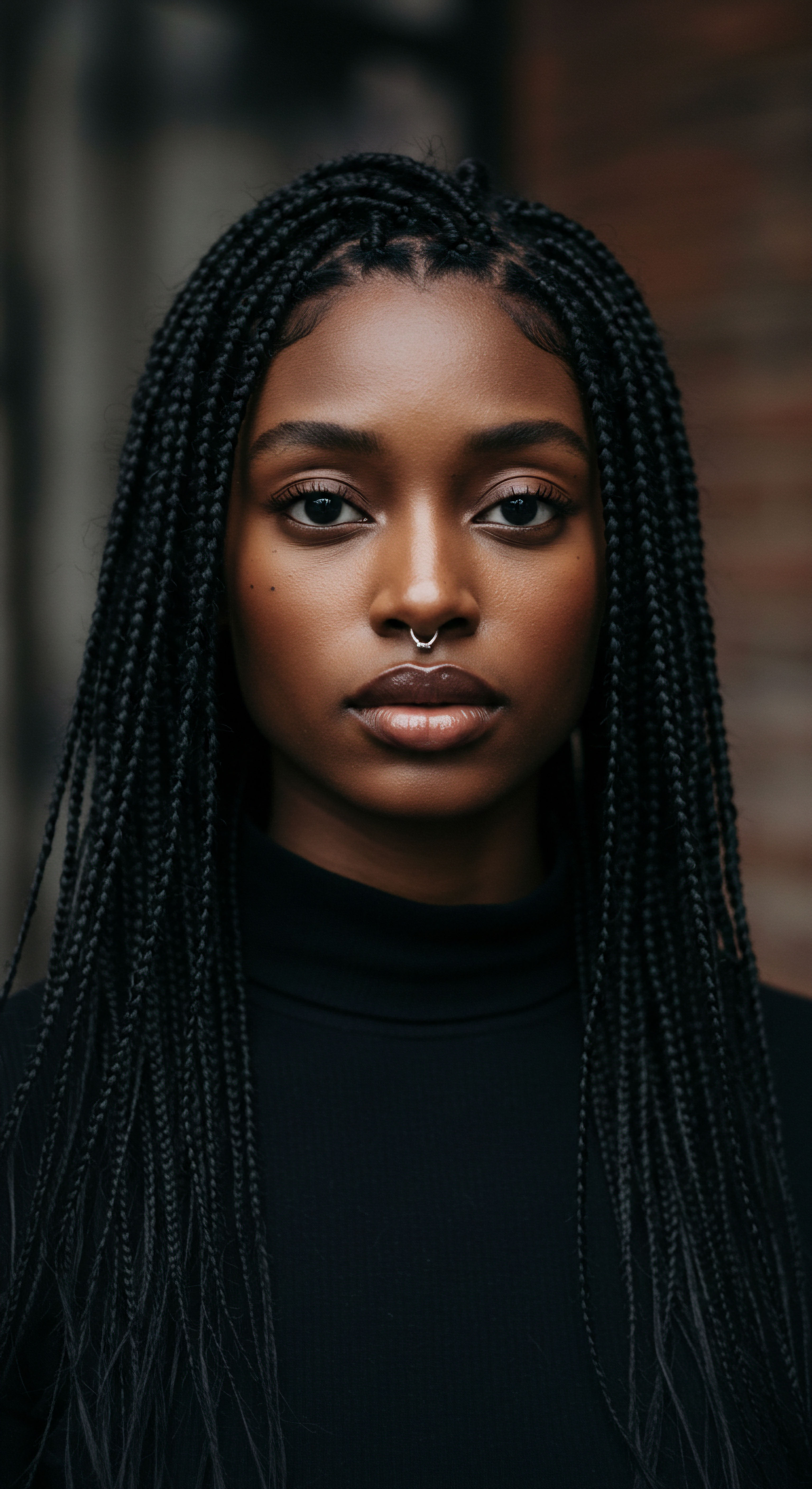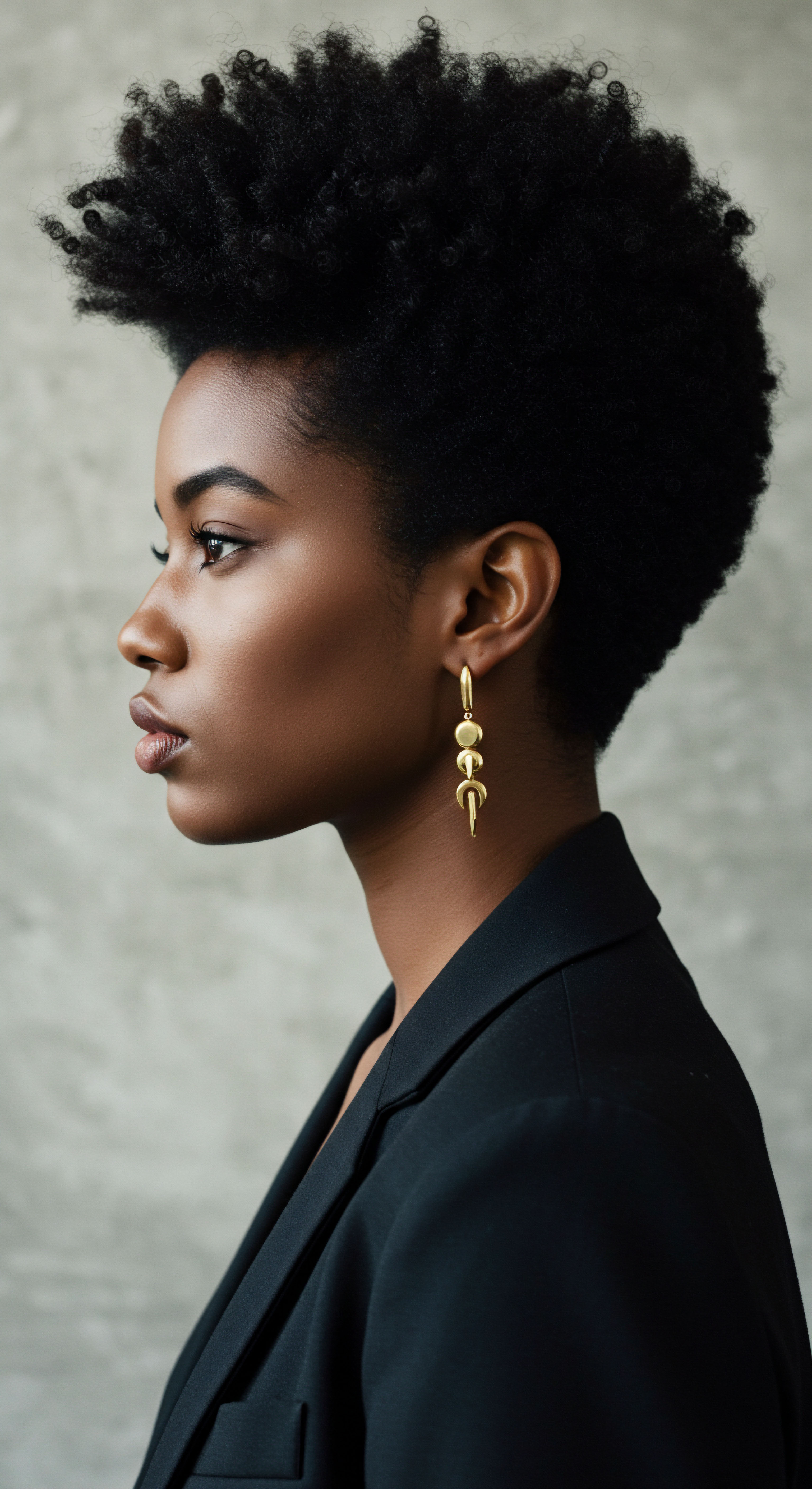
Roots
The stories held within a single strand of hair are ancient, whispers of identity and belonging stretching back through time. Consider, for a moment, the quiet reverence often observed when hair is cared for, the tender touch, the shared moments of connection. This simple act, so commonplace today, carries an echo of its earliest significance, particularly across the African continent.
For countless generations, hair has been far more than mere adornment; it has served as a profound visual language, a living chronicle of lineage, status, spirituality, and community. Its history is not merely a chronicle of styles, but a deep exploration of cultural resilience and creative expression.

Hair as a Living Chronicle
In pre-colonial African societies, hair was a powerful marker, its styling a complex code understood by all. The intricate patterns, the chosen accessories, the very way hair was kept or altered, conveyed vital information about an individual’s age, marital status, social standing, religious beliefs, and even their ethnic group. These traditions were not static; they evolved with communities, adapting to environmental factors and social shifts. The Sahara’s dry winds or the humid air of the rainforests, for instance, influenced the practicalities of hair care, leading to styles that protected the scalp and preserved moisture.
For many West African groups, elaborate braiding patterns could denote a woman’s readiness for marriage or a man’s warrior status. Among the Yoruba, the specific way hair was braided could signal devotion to a particular deity. The Mangbetu people of Central Africa were renowned for their elongated head shapes, achieved through cranial modification, upon which they would construct magnificent, fan-like coiffures that emphasized their aristocratic standing. Each style was a deliberate act of communication, a public declaration of who one was within the collective.
Hair in pre-colonial African societies served as a sophisticated visual language, communicating an individual’s identity, status, and spiritual connections.

Anatomy of Textured Hair
The unique structural qualities of African hair contributed to its diverse styling possibilities and its inherent resilience. Unlike straight hair, which typically grows from a round follicle, textured hair often emerges from an elliptical or oval-shaped follicle. This shape causes the hair strand to curl as it grows, forming coils, kinks, and waves of varying tightness.
The cuticle layers, which protect the inner cortex, may not lie as flat as those on straight hair, contributing to its distinct texture and, at times, its propensity for dryness. This natural architecture, while sometimes perceived as a challenge in modern contexts, was historically celebrated for its ability to hold intricate styles without the need for extensive artificial manipulation.
Understanding the fundamental biology of textured hair reveals why certain care practices and styling techniques became so integral to its upkeep and adornment. The inherent coil creates natural volume and strength, yet it also means that natural oils from the scalp struggle to travel down the entire length of the strand, making external moisture application a constant consideration.

Early Styling and Adornment
The earliest forms of African hair styling were deeply integrated with daily life and spiritual practices. Tools were crafted from natural materials – thorns for parting, shells for smoothing, plant fibers for extensions. Adornments were sourced from the natural world ❉ cowrie shells, beads made from seeds or clay, precious metals, and even dried flowers. These elements were not merely decorative; they held symbolic meaning, acting as talismans or indicators of wealth and protection.
For instance, the Himba women of Namibia are recognized for their striking “otjize” paste, a mixture of ochre, butterfat, and aromatic resins applied to both skin and hair. This practice offers sun protection, hygiene, and a distinctive aesthetic that signifies beauty and cultural affiliation. The painstaking process of creating these styles, often taking hours or even days, became communal rituals, moments for storytelling, bonding, and the transmission of cultural knowledge from elder to youth.
- Social Status ❉ Intricate styles often marked royalty, wealth, or specific societal roles.
- Spiritual Connection ❉ Hair was seen as a conduit to the divine, a sacred part of the body.
- Ethnic Affiliation ❉ Specific patterns and adornments identified individuals with their ancestral groups.
- Protection from Elements ❉ Styles were designed to shield the scalp and hair from sun, dust, and insects.
- Community Bonding ❉ The act of styling was a shared experience, strengthening social ties.
| Region West Africa |
| Associated Ethnic Groups Fulani, Wolof, Mende |
| Distinguishing Hair Practice Elaborate braiding, often with cowrie shells and amber beads, indicating marital status or wealth. |
| Region Central Africa |
| Associated Ethnic Groups Mangbetu, Kuba |
| Distinguishing Hair Practice Conical coiffures built upon elongated head shapes; intricate geometric patterns. |
| Region Southern Africa |
| Associated Ethnic Groups Zulu, Himba |
| Distinguishing Hair Practice Complex coiled styles, sometimes using red ochre paste (Himba); distinctive headwraps for married women (Zulu). |
| Region East Africa |
| Associated Ethnic Groups Maasai, Borana |
| Distinguishing Hair Practice Ochre-dyed braids or shaved patterns, signifying age sets, warrior status, or rites of passage. |

Ritual
As the sun rises, casting a soft glow upon the world, many engage in daily rituals, some mundane, others imbued with deeper meaning. For those with textured hair, these daily or weekly acts of care often carry an unspoken weight, a quiet continuation of practices that have endured through profound historical shifts. This section explores how the deliberate practices surrounding African hair traditions have been shaped, not only by personal preference or aesthetic desire, but by the relentless pressures and resilient responses to historical forces that sought to redefine identity.

The Disruption of the Transatlantic Slave Trade
The arrival of the Transatlantic Slave Trade marked a devastating rupture in African hair traditions. Enslaved Africans were forcibly stripped of their cultural markers, including their elaborate hairstyles. The harsh conditions of the Middle Passage and plantation life made traditional grooming practices impossible. Hair, once a symbol of pride and identity, became a source of shame or neglect.
Over time, simpler, often concealed styles became a necessity for survival, a way to minimize visibility and avoid further dehumanization. This period saw the suppression of a vibrant cultural heritage, replaced by a desperate struggle for basic existence.
The loss of tools, products, and communal grooming rituals was immense. The very act of caring for one’s hair, previously a moment of connection and cultural reinforcement, transformed into a private, often hurried, and difficult task. Yet, even in this profound adversity, sparks of resilience flickered.
Some individuals found ways to braid hair to map escape routes, hiding rice and seeds within cornrows for survival during flight. These acts, born of desperation, became quiet forms of resistance, transforming hair into a clandestine tool for liberation.

Post-Emancipation and the Pressure to Conform
Following emancipation, African Americans faced a complex landscape. While physical chains were broken, societal pressures to conform to Eurocentric beauty standards tightened. The desire for acceptance, economic opportunity, and social mobility often led to the adoption of hairstyles that mimicked European straight hair. This era saw the rise of the hot comb and chemical relaxers, tools and products designed to alter the natural texture of Black hair.
Figures like Madam C.J. Walker, while building a formidable business empire and empowering many Black women economically, also inadvertently contributed to the normalization of straightened hair as a symbol of respectability and advancement.
The pursuit of “good hair” – a term often associated with straighter, more manageable textures – became a pervasive ideal, deeply intertwined with notions of professionalism and beauty within a society that valued whiteness. This internalizing of external standards represented a profound psychological and cultural shift, a difficult compromise many felt compelled to make for the sake of survival and perceived progress.
The historical journey of African hair reveals a constant tension between cultural preservation and the pressures of assimilation, particularly evident in the adoption of straightening practices.

The Civil Rights Movement and Natural Hair Reclamation
The mid-20th century witnessed a powerful resurgence of Black pride and identity, fueled by the Civil Rights Movement. The “Black Is Beautiful” movement became a rallying cry, asserting the inherent beauty of Black features, including natural hair. The Afro, a bold and unapologetic celebration of coiled texture, emerged as a symbol of defiance, self-acceptance, and political solidarity. It was a visible rejection of Eurocentric beauty norms and a declaration of cultural sovereignty.
This period marked a conscious decision by many to return to their natural textures, often facing social backlash and professional repercussions. Wearing an Afro or cornrows was not merely a fashion statement; it was a political act, a visual protest against systemic oppression. This wave of reclamation laid foundational stones for future generations to explore and celebrate the diversity of textured hair without compromise.

Protective Styling and Nighttime Sanctuary
Throughout these historical periods, certain styling practices persisted or evolved as essential components of hair care and preservation. Protective Styling, such as braids, twists, and locs, served a dual purpose ❉ they protected the hair from environmental damage and manipulation, promoting length retention, while also providing a canvas for artistic expression and cultural continuity. These styles allowed individuals to maintain their hair’s health even under challenging circumstances, embodying a deep, practical wisdom.
The tradition of protecting hair during sleep also gained significance. Headwraps, scarves, and later, bonnets, became indispensable tools for preserving hairstyles, retaining moisture, and preventing tangles. These nighttime rituals transformed into quiet moments of self-care, safeguarding the hair’s integrity and extending the life of protective styles. This simple act of wrapping one’s hair before bed became a symbol of diligent care, a quiet continuation of practices passed down through generations, ensuring the hair’s well-being in anticipation of a new day.

Relay
How do the echoes of historical pressures continue to shape the contemporary landscape of African hair traditions, and what does this ongoing dialogue reveal about identity in the modern world? The journey of African hair is not confined to the past; it is a dynamic, ongoing story, deeply intertwined with global economics, social justice movements, and the evolving digital sphere. Understanding its present requires acknowledging the persistent influence of historical forces, particularly as they manifest in spaces where appearance intersects with opportunity and acceptance.

Modern Hair Politics and Legislation
In recent decades, the politics surrounding Black hair have taken center stage in legal and social discourse. Despite significant progress, discrimination based on natural hair textures and protective styles remains a pervasive issue in schools and workplaces. This persistent bias highlights how deeply ingrained Eurocentric beauty standards are within societal structures.
The ongoing struggle for acceptance has led to legislative action, such as the CROWN Act (Creating a a Respectful and Open World for Natural Hair). This legislation, enacted in various states across the United States, prohibits discrimination based on hair texture and protective styles, seeking to dismantle policies that disproportionately penalize Black individuals for their natural appearance.
The very existence of such legislation underscores a continuing need to protect fundamental rights related to self-expression and cultural identity. The CROWN Act represents a collective recognition that hair discrimination is a form of racial discrimination, impacting educational opportunities and career advancement. It is a legal affirmation of the inherent professionalism and beauty of textured hair.

The Unseen Burden of Bias in Professional Spaces
The impact of hair discrimination extends beyond overt policies; it manifests in subtle biases that affect opportunities. A revealing study by Koval and Rosette (2020) demonstrated that Black women with natural hairstyles were perceived as less professional and less competent, receiving fewer recommendations for job interviews compared to Black women with straightened hair and white women with straight or curly hair. This bias was particularly pronounced in industries with conservative appearance norms, such as consulting.
This research offers a powerful illustration of the systemic hurdles faced by Black women. The societal expectation to alter one’s natural hair texture for professional acceptance creates an invisible burden, often involving significant time, financial investment, and potential damage to hair health from chemical processes. Furthermore, the 2023 CROWN Workplace Research Study, commissioned by Dove and LinkedIn, found that Black women’s hair is 2.5 times as likely as white women’s hair to be perceived as “unprofessional.” The study also revealed that approximately two-thirds (66%) of Black women feel compelled to change their hair for a job interview, with 41% specifically transitioning from curly to straight styles. This data paints a stark picture of the compromises individuals often feel pressured to make in pursuit of professional advancement, showcasing a deeply embedded bias that demands ongoing challenge.
Hair discrimination in professional settings creates an unseen burden for Black women, often forcing a choice between authenticity and perceived opportunity.

Global Market Shifts and Digital Connections
The natural hair movement has not only spurred social change but has also reshaped global economies. The market for relaxers has seen a significant decline, with spending on perm relaxers falling by 30.8% between 2011 and 2016 alone. This shift reflects a conscious consumer choice, moving away from chemical alterations towards products that support and celebrate natural textures. This has opened vast opportunities for Black-owned businesses and brands specializing in natural hair care, fostering economic empowerment within the community.
The digital age has played a substantial part in this global shift. Social media platforms have become vibrant hubs for sharing information, techniques, and personal hair journeys. These online communities provide spaces for learning, support, and collective celebration, breaking down geographical barriers and amplifying diverse voices. This digital connectivity has democratized access to hair knowledge, allowing individuals to explore their textures and find inspiration without relying on mainstream beauty narratives that historically excluded them.

The Complexities of Cultural Appreciation
As textured hairstyles gain wider visibility, discussions around cultural appropriation have intensified. While increased appreciation for diverse hair traditions can be positive, instances where non-Black individuals adopt these styles without understanding their historical or cultural context can be problematic. This highlights the delicate balance between genuine admiration and the erasure of cultural significance. The conversation around hair remains a sensitive barometer of broader societal understandings of race, identity, and respect.
Simultaneously, scientific advancements continue to deepen our understanding of textured hair biology. Research into specific protein structures, moisture retention, and scalp health has led to the development of more effective and targeted hair care products. This scientific rigor complements the cultural wisdom, providing tools and knowledge that empower individuals to care for their hair with greater efficacy and confidence.
- CROWN Act ❉ Legislative efforts to prohibit discrimination based on natural hair.
- Economic Empowerment ❉ Growth of Black-owned businesses in the natural hair care sector.
- Digital Community ❉ Social media platforms facilitating knowledge sharing and connection.
- Cultural Dialogue ❉ Ongoing conversations about appreciation versus appropriation of hairstyles.
| Period 1960s-1970s |
| Social/Legal Milestone "Black Is Beautiful" movement, Afro gains prominence as a symbol of pride. |
| Market Shift/Trend Early shifts away from straightening, but limited product availability for natural textures. |
| Period Early 2000s |
| Social/Legal Milestone Second wave of natural hair movement, spurred by online communities and documentaries. |
| Market Shift/Trend Initial decline in relaxer sales; rise of independent natural hair brands. |
| Period 2010s-Present |
| Social/Legal Milestone Passage of CROWN Act legislation in various states across the U.S. |
| Market Shift/Trend Significant growth in the natural hair care market; mainstream beauty companies adapt product lines. |
| Period Ongoing |
| Social/Legal Milestone Continued advocacy against hair discrimination in schools and workplaces. |
| Market Shift/Trend Increased demand for transparent ingredient lists and sustainable practices in hair care. |
| Period These milestones demonstrate the interconnectedness of social progress and economic evolution in the realm of textured hair. |

Reflection
The story of African hair is a living testament to resilience, adaptation, and unwavering spirit. From the communal artistry of ancient civilizations to the defiant statements of the Civil Rights era and the vibrant digital communities of today, hair has consistently served as a profound mirror reflecting societal shifts and personal strength. It carries within its coils and kinks the memory of journeys, both forced and chosen, and the enduring beauty of a heritage that refuses to be diminished. The dialogue around textured hair continues, reminding us that understanding its history is not merely an academic pursuit, but a vital step in appreciating the depth of identity it holds for millions across the globe.

References
- Koval, Christy Zhou, and Ashleigh Shelby Rosette. “The Natural Hair Bias in Job Recruitment.” Social Psychological and Personality Science, vol. 11, no. 8, 2020, pp. 1097-1106.
- Mbilishaka, Afiya M. et al. “Don’t Get It Twisted ❉ Untangling the Psychology of Hair Discrimination Within Black Communities.” American Journal of Orthopsychiatry, vol. 90, no. 5, 2020, pp. 590-599.
- Wilkerson, Kamina. “The Natural Hair Movement.” JSTOR Daily, 3 July 2019.
- Goodman, Rebecca. “Wear Your Crown ❉ How Racial Hair Discrimination Impacts the Career Advancement of Black Women in Corporate America.” National University, 2021.
- Dove and LinkedIn. “2023 CROWN Workplace Research Study.” 2023.
- Johnson, Jennifer L. “Examining Culture, Economy, And Domestic Human Hair Consumption By African American Women.” Scholar Commons, 2017.
- Moore, Sarauna. “Black women’s natural hair care communities ❉ social, political, and cultural implications.” Smith College School for Social Work, 2013.
- Onwuasor, Ukamaka. “THE NATURAL HAIR MOVEMENT AND ITS IMPACT ON NATURAL HAIR CARE BUSINESS IN NIGERIA ❉ Analyzing the external environment for strategic advantage.” Oxford Brookes University, 2018.